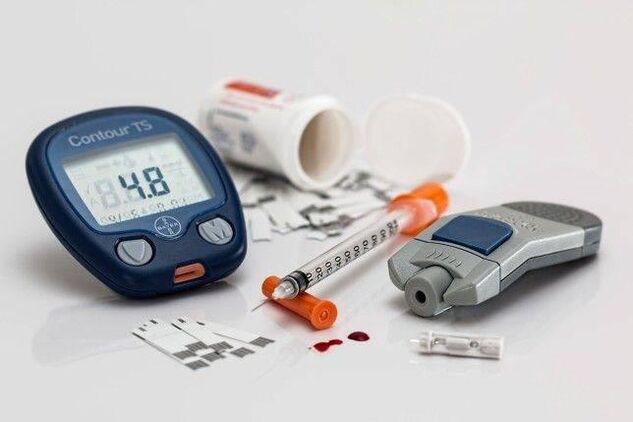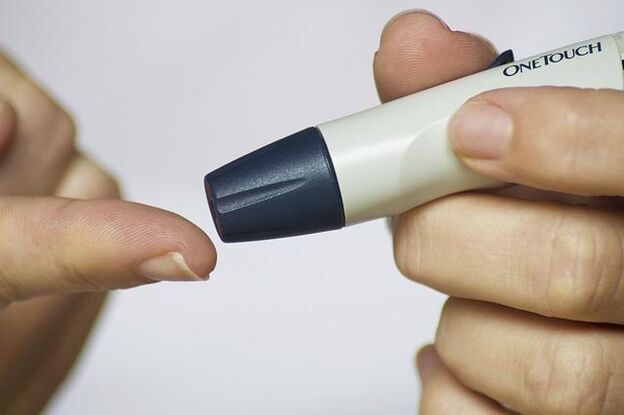
Diabetes is a severe endocrine disease with severe insulin deficiency. The disease is considered incurable and treatment with folk remedies at home only worsens the symptoms.
There are several reasons for the onset of the disease. A viral illness, genetic predisposition, medication, or a difficult pregnancy can cause a seizure.
Types of diabetes
There are noticeable symptoms and signs of the disease, such as bronchitis or coughing. Depending on the different types of diabetes, 5 are distinguished.
- 1 type. The immune system attacks the pancreas, which does not release enough insulin, which is responsible for glucose metabolism. Type 1 diabetes has traditionally been a problem in young people. Among cases of diabetes, the first type accounts for one-tenth.
- Type 2. Human organs and tissues lose their insulin sensitivity. It is noteworthy that the pancreas produces this substance in normal amounts. The second type of disease affects 90% of diabetics.
- Gestational diabetes. Appears only in women during pregnancy. This type of diabetes mellitus differs from other types in that it often disappears after the baby is born. Only 5 percent of expectant mothers experience it.
- secondary diabetes. A health condition in which various disorders lead to an increase in glucose levels. This type is the result of hormonal failure, medication, chronic inflammation of the pancreas, or removal of the pancreas.
- prediabetes. Appears when there are no health problems. The patient's sugar level is at the maximum level for a long time. This is due to heredity, poor lifestyle, malnutrition and obesity.
The first two types of diabetes are not completely curable. However, through diet, treatment, and moderate exercise, people with such a diagnosis live long and normal lives.
Symptoms of diabetes

Symptoms of the disease often do not appear immediately. As a result, the disease is hidden for a long time without revealing its presence.
There are cases in medicine where the onset of diabetes comes as a surprise. The patient will seek medical advice for a particular illness and will become aware of the diabetes after successful completion of the tests.
People often suffer from two types of diabetes, each with its own symptoms. A number of common symptoms can be identified.
- Thirst. It is a major messenger of diabetes, regardless of type. However, other diseases also cause thirst, so doctors do not focus on this symptom when making a diagnosis.
- Frequent urination. The symptom is common to both types of disease. Frequent urination often indicates a violation of the urinary system.
- Fatigue. Drowsiness and chronic fatigue are symptoms that accompany all kinds of illnesses, the list of which includes diabetes.
- Low temperature. Most often, people with the disease drop their body temperature - below 36 degrees.
- Fast weight loss with increased appetite. Those who want to eat constantly and lose weight for no reason need to be vigilant and have a test done.
- Low tissue regeneration. In the case of diabetes, even small damage to the skin heals for a long time. There are often ulcers and crying wounds.
- Vision impairment. Some diabetics complain that a white "veil" appears in front of their eyes and the image becomes blurred. But vision can deteriorate with age.
- Impaired circulation in the limbs. It manifests itself in tingling and numbness. Cramps often appear in the calf muscle.
- Deterioration of potency. Men with diabetes often have erectile problems. In women, the disease causes dehydration of the genitals.
Keep in mind that the severity of your symptoms depends on the characteristics of your body. One person has the symptoms listed, while the other is absent. The stage of the disease also affects the severity of the symptom. In case of severe violation of insulin secretion, the symptoms are more pronounced.
Treatment of diabetes with folk remedies
Diabetes catches up with a person when the pancreas is unable to cope with its functions and releases small amounts of insulin. This substance helps the body break down sugars. As a result, excessive amounts of sugar are excreted in the urine. And although doctors are constantly analyzing the progression of the disease, effective treatments have not yet been developed.
Treatment of diabetes mellitus at home with folk remedies is allowed under the mandatory supervision of an endocrinologist. The main factor in therapy that affects the course of the disease is diet.
Carbohydrates are excluded from the diet. If this is not possible, their consumption will be reduced. It is recommended to use products containing xylitol, sorbitol or starch instead of the usual sugar.
The list of folk remedies used to treat diabetes is represented by natural fruits, vegetables, herbs and berries. Often the individual ingredients are used together, which increases the healing effect.
- clover infusion. Mix a portion of the clover grass with an equal amount of boiling water and wait three hours. Drink the drug before meals with 0, 33 cups. Add flowers to enhance the effect.
- blueberries with leaves. Pour a cup of boiling water over a spoonful of dried leaves, wrap it and wait 30 minutes for the liquid to absorb. After carefully filtering the infusion, drink one cup three times a day.
- walnut leaves. Grind two dozen green walnut leaves, place in a pan, pour a glass of liquid, bring to a boil and boil for 10 minutes. Take the remedy during the day without restriction.
- herbal collection. Mix twenty grams of blueberry leaves, birch buds, pansies and nettles, add five grams of St. John’s wort with ten grams of dandelion roots, mix and chop. Pour four tablespoons of the mixture into a cup of boiling water from the jug, wait a while, strain and take 0. 33 cups three times a day.
- burdock roots. It is consumed with boiled or fried cheese. Some people use burdock root instead of potatoes and add it to soups and meatballs.
- Blueberry decoction. Bring a spoonful of leaves along with the shoots to a simmer, then cool slightly and strain. This drug should be treated with one spoon three times a day.
As the disease is severe, start therapy immediately. Shared recipes help.
What to eat with diabetes

Continuing the topic of conversation, we will discuss what to eat with diabetes. Doctors say that nutrition plays a significant role in treating the disease because the process of utilizing the glucose that enters the body through food is disrupted.
High levels of the substance in the blood contribute to the development of complications and have a pathological effect on the body. However, in diabetes, proper nutrition has a therapeutic effect.
Therapeutic nutrition is aimed at normalizing carbohydrate metabolism. This reduces the load on the pancreas. It is recommended to eat frequently and regularly, evenly distributing or limiting carbohydrate intake. The diet should include high-protein foods in addition to low-fat foods. The list of preferred food processing methods is steaming, steaming and baking.
I will show you the foods that are recommended for diabetics. Many foods are allowed to be consumed, all you need to do is monitor your calorie content and carbohydrate saturation.
List of foods authorized for diabetes
- Fish and meat. Skinny types only. Doctors advise taking veal, chicken, rabbit, cod, perch and pike for cooking. Consumption of small quantities of seafood and canned fish is allowed.
- Dairy products. Prefer skim milk and kefir. Eggs are allowed. Eat twice a day.
- Flour products from rye flour with bran. You can also consume small amounts of pasta. Fiber-rich pasta is best.
- Barley, buckwheat, oats and millet groats. Make porridge or fragrant soup from cereals. Rice and semolina are better to refuse as they increase blood sugar levels.
- Vegetables rich in fiber. Broccoli, beans, zucchini, cabbage, eggplant and radishes. Do not abuse beets and potatoes. Simmer or fry the vegetables.
- Berries and fruits. Include sour apples, pears, currants and citrus fruits in your diet. Remove watermelons, melons, raisins, bananas, grapes and figs from your diet.
- Dietary sweets. The preparation must contain sugar substitutes. Dietary halva and honey can be used.
- Pumpkin and sunflower seeds. These dried foods are rich in fiber, vitamins, trace elements and beneficial acids. Walnuts are allowed, but the daily intake of peanuts or walnuts should not exceed 50 grams.
- The drinks. Decoctions, teas, compotes, jelly and juices are considered extremely useful. Carbonated mineral water and alcohol are permitted in which the sugar content does not exceed 5 per cent. You better not drink coffee.
In addition, I will list more foods and spices that lower sugar. These are parsley, tomatoes, onions and zucchini, cucumbers, black currants and gooseberries, turmeric, ginger and cinnamon.
How to prevent the development of diabetes?
Every diabetic knows that just a lot of effort ensures a normal life. Otherwise, the disease dictates the rules. Prevention helps prevent the development of the disease and minimizes the likelihood of complications.
The development of the first type of disease cannot be prevented. There are activities that focus on the second type.
Proper nutrition. This is the foundation of good health. Keep in mind that being overweight and obese will speed up the onset of the disease, so make sure you are on a proper diet.
Compliance with water management. Seventy percent of the human body is water, which helps digest food and remove decomposition residues. In diabetes, fluid is involved in a number of processes.
Sports. Diabetics are overweight. If you pay attention to sports, you can stop the disease from developing. Physical activity is an essential part of prevention.
Emotional mood and state of mind play an equally important role in life. Nerves contribute to the onset of disease, so attend training for prevention, see a doctor, fight depression.
It is forbidden to take medications without a prescription, otherwise the situation will get worse.
In this article, we looked at the types of diabetes, identified the symptoms of the disease, considered treatment at home, and figured out what to eat with it and how to proceed to prevent it. Use the acquired knowledge at your own discretion, but do not forget to consult a doctor. Good health!

























